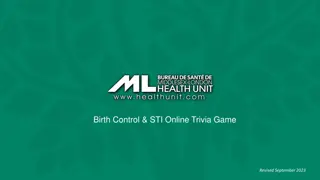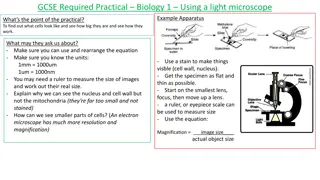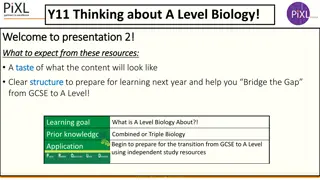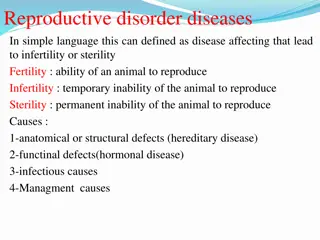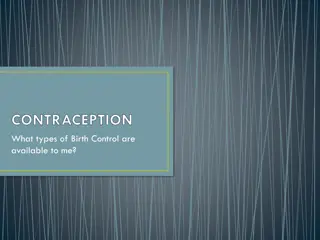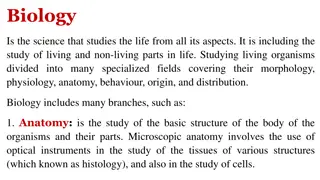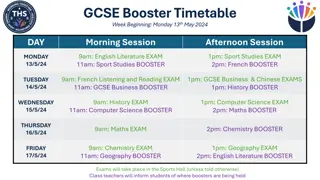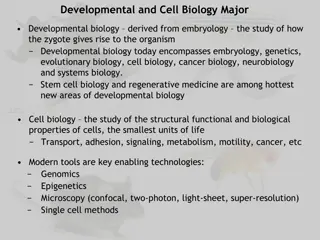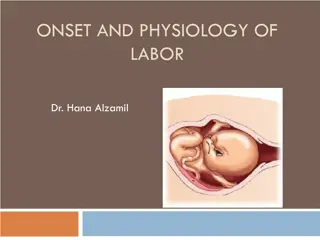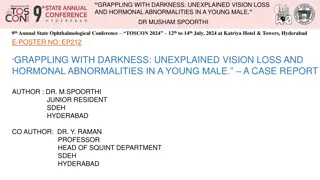Hormonal Control in Animals: GCSE Biology Lesson
Explore the fascinating world of hormonal control in animals through this GCSE Biology lesson. Learn about hormones, the endocrine system, glands, and their roles in maintaining homeostasis. Understand the advantages and disadvantages of hormonal coordination, and study specific hormones and their functions in different organs. Enhance your understanding of the master gland and its pivotal role in the body's stress response. Engage in activities designed to cater to various abilities within the classroom while maintaining social distancing protocols.
Download Presentation

Please find below an Image/Link to download the presentation.
The content on the website is provided AS IS for your information and personal use only. It may not be sold, licensed, or shared on other websites without obtaining consent from the author.If you encounter any issues during the download, it is possible that the publisher has removed the file from their server.
You are allowed to download the files provided on this website for personal or commercial use, subject to the condition that they are used lawfully. All files are the property of their respective owners.
The content on the website is provided AS IS for your information and personal use only. It may not be sold, licensed, or shared on other websites without obtaining consent from the author.
E N D
Presentation Transcript
Click and Teach GCSE BIOLOGY Click and Teach GCSE BIOLOGY TOPIC: HORMONAL CONTROL IN ANIMALS You should have your book (or paper) and a pen
Aims of the lesson Aims of the lesson In order to maintain social distancing and keep everyone safe: (a) You will need to copy from the board, rather than have worksheets (b) Each task increases in difficulty, to cater for all abilities within the classroom (c) Put your hand up if you need some help, but don t leave your seat. (d) Don t share equipment, and keep your work with you at the end of the lesson.
Write these questions 1. What are hormones? 2. How do hormones travel around the body? 3. What is the endocrine system? 4. What does a gland do? 5. What is an advantage of the endocrine system? 6. What is a disadvantage of the endocrine system? 7. What is the master gland ? 8. What is the role of the master gland? 9. Draw and label the above diagram into your books 10. Copy the table below of hormones, their roles, the glands that release them and their target organs
Hormones are chemical messengers that travel round the body. The endocrine system is the name of the series of organs and glands which coordinate changes in the body using hormones. A gland secretes a hormone into the blood. The hormone travels through blood stream until it reaches its target organ. The advantage of hormonal coordination is it can have a more long lasting effect. The disadvantage is that it takes longer to work. A good example of this is puberty. Sex hormones (oestrogen and testosterone) are released from the sexual organs and cause the changes to the body over a number of years. The endocrine system has a master gland called the pituitary gland. It secretes a number of hormones which in turn affect other glands which secrete different hormones. It plays a large role in both homeostasis and our body s stress response.
Gland Hormone gland releases Role of hormone Target organ Thyroid gland Thyroxine Control metabolism Respiring cells, heart Adrenal gland Adrenaline Involved in fight or flight response Muscle cells, heart, liver Pancreas Insulin Controls blood glucose concentration by allowing uptake of glucose into cells Respiring cells, liver Testes (males) Testosterone Male sex hormone Reproductive organs Ovaries Oestrogen Thickens lining of uterus Uterus Ovaries Progesterone Maintains thickness of uterus lining Uterus Pituitary FSH (Follicle stimulating hormone) LH (Luteinising hormone) Stimulates follicle in ovaries to become a mature egg Causes follicle to rupture and release the mature egg (ovulation) Ovaries Pituitary Ovaries Pituitary TSH (Thyroid stimulating hormone) Stimulates thyroid gland to produce thyroxine Thyroid gland
Self Mark Answers 1. What are hormones? Chemical messengers 2. How do hormones travel around the body? Via the blood 3. What is the endocrine system? A series of organs and glands which coordinate changes in the body 4. What does a gland do? Releases hormones 5. What is an advantage of the endocrine system? Long lasting effects 6. What is a disadvantage of the endocrine system? Takes longer to work 7. What is the master gland ? Pituitary gland 8. What is the role of the master gland? Secretes large number of hormones 9. Draw and label the above diagram into your books 10. Copy the table below of hormones, their roles, the glands that release them and their target organs
WRITE THESE QUESTIONS 1. What is the role of insulin ? 2. What is the target organ of adrenalin? 3. Which gland produces testosterone? 4. Which hormones do the pituitary gland release? 5. What is the target organ of oestrogen? 6. What is the role of progesterone? 7. Which two hormones have the same target organ? (there are two answers here)
Self Mark Answers 1. What is the role of insulin ? Controls blood glucose concentration 2. What is the target organ of adrenalin? Muscle, liver, heart 3. Which gland produces testosterone? Testes 4. Which hormones do the pituitary gland release? FSH, LH, TSH 5. What is the target organ of oestrogen? Uterus 6. What is the role of progesterone? Maintains lining of uterus 7. Which two hormones have the same target organ? (there are two answers here) FSH, LH & Oestrogen and Progesterone
Click and Teach GCSE BIOLOGY Click and Teach GCSE BIOLOGY TOPIC: HORMONAL OF GLUCOSE You should have your book (or paper) and a pen
Aims of the lesson Aims of the lesson In order to maintain social distancing and keep everyone safe: (a) You will need to copy from the board, rather than have worksheets (b) Each task increases in difficulty, to cater for all abilities within the classroom (c) Put your hand up if you need some help, but don t leave your seat. (d) Don t share equipment, and keep your work with you at the end of the lesson.
WRITE THESE QUESTIONS 1) Why is a supply of glucose in our blood needed? 2) What will happen to the water in cells if there is too much glucose in the blood? 3) What is the effect of this on the red blood cells? 4) What will happen to the water in cells if there is too little glucose in the blood? 5) What is the effect of this on the red blood cells? 6) Copy the bullet points on what happens to your body when you eat and exercise into a flow chart in your exercise books 7) What makes blood glucose concentration increase? 8) What organ detects the rise in blood glucose? 9) What hormone does this organ produce? 10)What is the target organ for this hormone (where does it go?) 11) What is glucose converted to here for storage? 12)What two things can cause blood glucose concentration to fall? 13)Which organ detects this? 14)What hormone is secreted by this organ? 15)What is the target organ for this hormone?
We need a supply of glucose in our blood so that our cells can respire efficiently. The problem is glucose is soluble so affects the osmotic potential of the blood plasma. If there is too much sugar in the blood then water will leave the red blood cells, by osmosis through the cell membrane. This causes the red blood cells to shrivel and become unable to carry oxygen. Conversely, if there is too little glucose in the plasma then the water will move from the plasma to the red blood cells by osmosis. This causes the red blood cells to swell and even burst. The endocrine system is responsible for maintaining a constant blood glucose level in the body. When you eat your blood sugar rises: A) The pancreas detects the rise in blood glucose B) The pancreas secretes insulin into the blood stream C) The insulin travels to the liver and muscle cells where it binds to protein receptors on the cell membrane D) This allows the liver and muscles absorbs the glucose and converts it in to glycogen E) Blood glucose returns to normal When you exercise or fast your blood sugar falls: A) The pancreas detects the fall in blood glucose The pancreas is the main organ responsible for detecting and controlling the blood glucose levels of the blood. The liver plays a role in the storing of glucose as insoluble glycogen. B) The pancreas secretes glucagon into the blood stream C) The glucagon travels to the liver D) The liver converts glycogen to glucose and releases it in to the blood E) Blood glucose returns to normal
WRITE THESE QUESTIONS 1) Why is a supply of glucose in our blood needed? our cells can respire efficiently 2) What will happen to the water in cells if there is too much glucose in the blood? water will leave the red blood cells, by osmosis through the cell membrane. 3) What is the effect of this on the red blood cells? shrivel and become unable to carry oxygen 4) Copy the bullet points on what happens to your body when you eat and exercise into a flow chart in your exercise books 5) What makes blood glucose concentration increase? Eating glucose 6) What organ detects the rise in blood glucose? Pancreas 7) What hormone does this organ produce? Insulin 8) What is the target organ for this hormone (where does it go?) Respiring cells/ liver 9) What is glucose converted to here for storage? Glycogen 10)What two things can cause blood glucose concentration to fall? Exercise, fasting 11)Which organ detects this? Pancreas 12)What hormone is secreted by this organ? Glucagon 13)What is the target organ for this hormone? Liver
Write these questions 1. Copy the above table into your exercise book 2. How many types of diabetes are there? 3. Which type is typically caused by lifestyle factors? 4. What is the typical age of onset of type 1 diabetes? 5. What is the treatment for type 2 diabetes? 6. What is the treatment for type 1 diabetes?
Type 1 Body s immune system accidently attacking pancreas cells Increased thirst, increased urination, glucose in urine, blurred vision, tiredness and fatigue Type 2 Diabetes is a disorder where a person cannot control their blood glucose concentration on their own. It comes is two forms summarised below. The symptoms for both types of diabetes are similar. A patient suffering from diabetes may experience increased frequency of urination. This is because the levels of blood glucose rise and the kidneys are unable to reabsorb the glucose, so it is passed in urine. Due to an increased frequency in urination, the patient may experience excessive thirst, this is to replenish lost water due to urination. As glucose in needed in cells for respiration, a patient with diabetes may experience fatigue, tiredness or lethargy. This is because glucose is not being absorbed by the cells either because they are not responsive to insulin (type 2) or insulin simply isn t being produced (type 1) and is remaining in the blood. Blurred vision may occur as, because the levels of glucose are so high in the blood, some glucose builds up behind the lens and cornea of the eye, therefore making vision blurred. Poor diet and obesity over a long period of time Caused by Increased thirst, increased urination, glucose in urine, blurred vision, tiredness and fatigue Symptoms Typical age of onset Childhood Adulthood Beta cells in pancreas no longer produces insulin Cells unable to recognise insulin in the blood Effect Consequenc e Blood sugar rises Blood sugar rises Carbohydrate controlled diet, exercise and medication Treated by Injections of insulin
Self Mark Answers 1. In book 2. 2 3. Type 2 4. Childhood 5. Reduced carbohydrates and exercise 6. Insulin injections
Write these questions 1. Name the endocrine gland that controls blood glucose level (BGL). 12. State three symptoms of diabetes. 13. *Explain why diabetic patients may lose weight. 2. What is the effect of insulin on BGL? 3. Name the hormone that increases BGL. 14. Suggest two risk factors for developing diabetes. 4. Name the organ that secretes the two hormones to regulate BGL. 15. *State two ways to diagnose someone as diabetic. 5. When would a person s BGL increase during a day (24hr)? 16. Compare the treatments of types 1 and 2 diabetes. 6. Explain the primaryreason why a person s BGL would decrease eventually. 17. One type of diabetes can be cured. State which one it is and explain how. 7. Describe the actions of insulin how does it lower BGL? 18. *Following the question above, suggest a problem with the treatment. What is a possible solution to this problem? 8. Describe the actions of glucagon. 9. Explain the importance of maintaining a stable blood glucose level. 19. *Explain why insulin injection is not an appropriate treatment for type 2 diabetes. 10. What is diabetes? 11. Describe two differences between types 1 and 2 diabetes.
1. 2. 3. 4. 5. 6. 7. 8. 9. 10. Diabetes is a disorder where a person cannot control their blood glucose concentration on their own 11. Type 1 caused by immune system attacking insulin producing beta cells in pancreas, type 2 caused by poor diet and lack of exercise, onset of type 1 diabetes is usually childhood, onset of type 2 diabetes usually adulthood. 12. Increased thirst, increased urination, glucose in urine, blurred vision, tiredness and fatigue 13. Glucose is not being up taken and stored in cells as glycogen 14. Lack of exercise, high carbohydrate diet 15. Test blood glucose levels, test urine for high levels of glucose 16. Type 1 insulin injections type 2 exercise and carbohydrate controlled diet 17. Type 2 diabetes, Lack of carbohydrates reduces glucose in blood, exercise increases use of glucose for respiration, both actions decrease BGL 18. Problem with treatment is that people suffering from type 2 diabetes are less likely to change lifestyle factors 19. Patients with type 2 can still produce insulin, cells just aren t responsive to it so treatment would be ineffective. Pancreas Decreases BGL Glucagon Pancreas After they have consumed breakfast, lunch , dinner and snacks Fasting Binds to protein receptors on cell membranes and allows glucose to enter cells Glucagon converts glycogen to glucose which enters blood and increases BGL Glucose affects the osmotic potential of blood plasma Self Mark Answers
Exam questions 1. It is important that the concentration of glucose (sugar) in the blood is controlled. (a) (i) Which hormone controls the concentration of glucose in the blood? (ii) Which organ produces this hormone? (b) The concentration of glucose in the blood of two people, A and B, was measured every half an hour. 2. 3. 4. (i) person B rise after drinking the glucose drink? By how much did the blood glucose concentration in 5. One hour after the start, both people drank a solution containing 50 g of glucose. The graph shows the result. (ii) A doctor suggests that person A has diabetes. Give two pieces of evidence from the graph to support this suggestion. 6. (iii) concentration in person B, shown in the graph. Give one reason for the fall in blood glucose
Click and Teach GCSE BIOLOGY Click and Teach GCSE BIOLOGY TOPIC: HUMAN REPRODUCTIVE HORMONES (THE MENSTRUAL CYCLE) You should have your book (or paper) and a pen
Aims of the lesson Aims of the lesson In order to maintain social distancing and keep everyone safe: (a) You will need to copy from the board, rather than have worksheets (b) Each task increases in difficulty, to cater for all abilities within the classroom (c) Put your hand up if you need some help, but don t leave your seat. (d) Don t share equipment, and keep your work with you at the end of the lesson.
Questions: One of the most vital roles of the endocrine system is in coordinating the reproductivesystem. As mentioned before, during puberty testosterone is made in the testes in high levels. This causes males to develop the secondary sex characteristics of body hair, deeper voice, sperm production etc.. Likewise the ovaries secrete oestrogen which causes females to develop breasts, grow body hair, widen their hips and they begin to ovulate. 1. What is the function of the endocrine system? 2. What is the name of the male sex hormone and where is it produced? 3. What is the name of the female sex hormone and where is it produced? 4. What hormone causes and egg to develop in the ovary? 5. What hormone causes the egg cell to be released? 6. What is the role of progesterone? 7. Why might women with low levels of FSH find it hard to conceive a baby? Hormones also play a vital role in coordinating the female menstrual cycle. The function of the menstrual cycle is to ensure that the female body is prepared to conceive a baby at regular intervals. Most women have a menstrual cycle of 28 days although this can vary. The menstrual cycle is a complex system coordinated by 4 main hormones; Follicle stimulating hormone (FSH): This causes an egg cell to mature in the ovaries Luteinising hormone (LH): Stimulates the ovary to release the egg Progesterone and Oestrogen: These maintain the uterus lining so a fertilised egg can be implanted and develop into an embryo. If the egg is not fertilised the lining and egg are shed. This is noticed as a small volume of blood. This is called menstruation, although it is also known as a period
Self Mark Answers 1. Coordinate the reproductive system 2. Testosterone testes 3. Oestrogen ovaries 4. FSH 5. LH 6. Maintain thickness of uterus lining 7. Do not ovulate, no egg to be fertilised
Exam questions 1. The human body produces many hormones. (a) (i) What is a hormone? (1) (ii) Name an organ that produces a hormone. (1) (iii) How are hormones transported to their target organs? (1) (b) Describe how the hormones FSH, oestrogen and LH are involved in the control of the menstrual cycle. (2) 2. The diagram shows changes in the uterus lining during 28 days of a menstrual cycle. (a) Describe how changes in the lining shown in the diagram adapt it for its function if an egg is fertilised.
Click and Teach GCSE BIOLOGY Click and Teach GCSE BIOLOGY TOPIC: CONTRACEPTION You should have your book (or paper) and a pen
Aims of the lesson Aims of the lesson In order to maintain social distancing and keep everyone safe: (a) You will need to copy from the board, rather than have worksheets (b) Each task increases in difficulty, to cater for all abilities within the classroom (c) Put your hand up if you need some help, but don t leave your seat. (d) Don t share equipment, and keep your work with you at the end of the lesson.
Its hard to think of a world before contraception was available. Before contraception, every time a man and woman had sex there was a significant chance that a baby would be conceived. Some forms of contraception have also helped to stop the spread of sexually transmitted diseases like syphilis, gonorrhoea and HIV. Contraception is the word used to describe any technology that prevents pregnancy. Types of contraception broadly fall into two main categories; Hormonal and Non-hormonal. Hormonal: Hormonal: Given that we have just learnt about the complex roles the hormones play in the menstrual cycle it makes sense that we can manipulate them to trick the body and prevent pregnancy. Oral contraceptive pill: Contains oestrogen and progesterone to inhibit FSH. This prevents an egg maturing. Contraceptive implant: Contains a slow release version of progesterone. This ensures that an egg is not released from the ovary. The balance of each hormone in an individual is similar similar but not identical identical. This means that pharmaceutical companies make a variety of mixtures of the hormones. The aim is to find a version which work for the woman without side effects Non Non- -hormonal: hormonal: These are a broad range of very different strategies. Some only prevent pregnancy, others also provide protection from STI s Barrier methods: Mainly the condom or the diaphragm. Both of these provide a physical barrier that prevents sperm entering the uterus. The condom has an added advantage of preventing the spread of STI s. Correctly used a condom is 98% effective at preventing pregnancy, which is the best of all the methods available. Interuterine devices (IUD):Often called the coil they are tiny plastic or metal devices that are inserted into the uterus. They aim to mimic an implanted embryo, stimulating progesterone and oestrogen and prevent a mature egg begin released. Spermacidal gels: These kill sperm on contact. Often added to barrier methods to improve their effectiveness. Does not prevent the spread of STI s. Abstinence: Various apps are now available to monitor the menstrual cycle. By doing this they can predict when you will have a low chance of conceiving if you have sex. This is the least effective method as sperm can survive inside the oviduct for a number of days. Does not prevent the spread of STI s. Surgical sterilisation: This is when a person is preventing from releasing sperm or eggs due to a small surgical procedure. In males a vasectomy involved the sperm ducts being stitched up to prevent the sperm made in the testes reaching the penis. In women the oviducts can have a similar procedure to prevent eggs travelling to meet the sperm. In both cases these are permanent procedures and come with some short term discomfort while you recover from the operation. They do not prevent the spread of STI s. side effects.
Write these questions 1. What is the common purpose of all forms of contraception? 2. What are the two main categories of contraception? 3. Which forms of contraception also prevent STI s? 4. Which forms of contraception are permanent? 5. Which hormone is in both hormonal contraceptive methods? 6. Brad says I can t catch an STI because my girlfriend is on the pill Is he right or wrong? Give a reason. 7. Complete the sentences below: 8. The Abstinence method is not a very reliable method of contraception because.. 9. The Abstinence method is not a very reliable method of contraception but.. 10. Duncan says I don t like the feeling of a condom, but my girlfriend has bad side effects on the pill. I m not sure what to do? What advice would you give Duncan? Make sure you include reasons for any advice you give. 11. Why would it still be recommended that a homosexual male wear a condom?
Write these questions 12. The graph below shows some changes that occur during the menstrual cycle. a) the uterus thickens between days 7 and 27. The graph above shows that the lining of What is the purpose of thickening the lining of the uterus? Choose from: To allow implantation of the embryo To break down waste To prevent sperm reaching the egg (b) lining of the uterus? Which hormone causes thickening of the (c) occur? Use information from the graph above. On which day is fertilisation most likely to






